You are using an out of date browser. It may not display this or other websites correctly.
You should upgrade or use an alternative browser.
You should upgrade or use an alternative browser.
DEEP CYCLE BATTERIES and BUSH POWER
- Thread starter condor22
- Start date

Help Support Prospecting Australia:
This site may earn a commission from merchant affiliate
links, including eBay, Amazon, and others.
condor22 said:Hard Luck
Best of luck with your buy, I hope it works out for you in the long run. As you said, time will tell.
Thanks for the update.
Yeah, thanks. It will get used on weekdays for the next few months. Plus if I camp at all. So lets see how it pans out.
condor22
Mike
Maxtrax mounted. 
Next job - I'm replacing the 10 amp PWM solar controller in the 4x4 that came with the Ridge Ryder (RR) panel. I noted that regardless of how much sun or how much charge the battery needs, the voltage it puts out is always less than 14 v, mostly around 13.5.
My mate designed a MPPT controller, that is IP68 and 15 amp. It has a small wire that is a temperature sensor and if installed as it should be near the battery it senses ambient, which in the back of a vehicle can get quite hot. It adjusts to the temp in its charging.
Before I disconnect the PWM I'll put a 10 amp or so load on the battery, then turn the panel on to check it's voltage and solar input (amps). Won't take long to change it over and then I'll do the same with the MPPT to check the difference. Pics to come when I do the job tomorrow.
The RR is a 110 W panel and I still have my concertina 110 W. So I'll lower the battery state of charge, check the amps from the RR panel, then unplug it and plug in the Concertina to check amps. If the total is less than 15, then I could use both with a "Y" Anderson connection. In particular in winter time when both panels are likely producing less juice. If it's more than 15 amps, I might look at a 80 W to supplement the RR.
Next job - I'm replacing the 10 amp PWM solar controller in the 4x4 that came with the Ridge Ryder (RR) panel. I noted that regardless of how much sun or how much charge the battery needs, the voltage it puts out is always less than 14 v, mostly around 13.5.
My mate designed a MPPT controller, that is IP68 and 15 amp. It has a small wire that is a temperature sensor and if installed as it should be near the battery it senses ambient, which in the back of a vehicle can get quite hot. It adjusts to the temp in its charging.
Before I disconnect the PWM I'll put a 10 amp or so load on the battery, then turn the panel on to check it's voltage and solar input (amps). Won't take long to change it over and then I'll do the same with the MPPT to check the difference. Pics to come when I do the job tomorrow.
The RR is a 110 W panel and I still have my concertina 110 W. So I'll lower the battery state of charge, check the amps from the RR panel, then unplug it and plug in the Concertina to check amps. If the total is less than 15, then I could use both with a "Y" Anderson connection. In particular in winter time when both panels are likely producing less juice. If it's more than 15 amps, I might look at a 80 W to supplement the RR.
Bought a Projecta DC/Solar battery charger at the beginning of the year and hadnt gotten around to installing it yet.
I have a deep cycle battery and all the bibs and bobs for the install but Im perplexed as to where in the engine bay I can place the projecta unit.
I was thinking to get it as close to where the second battery is located and in a place away from the engine heat and that receives air flow whilst travelling.. so in front of the grill cross member on the passenger side next to the radiator.
It would be a tight squeeze but I cant see any other place I can located it.
Id also like to run leads to the back of the Prado to put an Anderson plug to the camper trailer.
Still working out where to place the Anderson plug for the solar panel connection that is accessible ..maybe behind the bull bar would be possible..
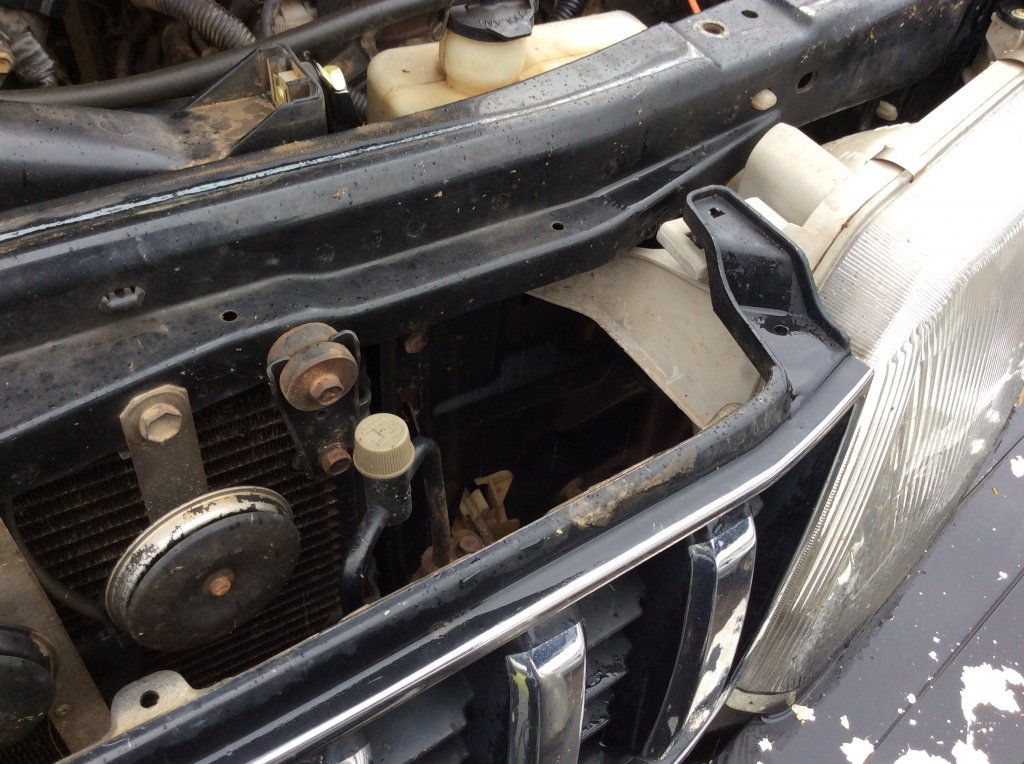
I can just squeeze it in here ....
Im thinking an alternative is to buy a battery box and run leads from the alternator to the back of the Prado. Use an Anderson plug and to connect to the alternator leads and run through a switch.. that way I can use the projecta battery and the box seperate from the Prado when and if I need to.
What do you guys recon ?
I have a deep cycle battery and all the bibs and bobs for the install but Im perplexed as to where in the engine bay I can place the projecta unit.
I was thinking to get it as close to where the second battery is located and in a place away from the engine heat and that receives air flow whilst travelling.. so in front of the grill cross member on the passenger side next to the radiator.
It would be a tight squeeze but I cant see any other place I can located it.
Id also like to run leads to the back of the Prado to put an Anderson plug to the camper trailer.
Still working out where to place the Anderson plug for the solar panel connection that is accessible ..maybe behind the bull bar would be possible..

I can just squeeze it in here ....
Im thinking an alternative is to buy a battery box and run leads from the alternator to the back of the Prado. Use an Anderson plug and to connect to the alternator leads and run through a switch.. that way I can use the projecta battery and the box seperate from the Prado when and if I need to.
What do you guys recon ?
condor22
Mike
Nucopia - Consider this, when you are driving, there is airflow. When you stop there isn't and there is likely to be radiated heat in the area of the radiator.
Easy to assess, go for a drive on a hot day, stop, turn engine off, wait 5 minutes and see how hot it is in the area where you are thinking of installing. Also check the operating temp range of the Projecta.
Easy to assess, go for a drive on a hot day, stop, turn engine off, wait 5 minutes and see how hot it is in the area where you are thinking of installing. Also check the operating temp range of the Projecta.
condor22
Mike
Solar controller installed.
As Was
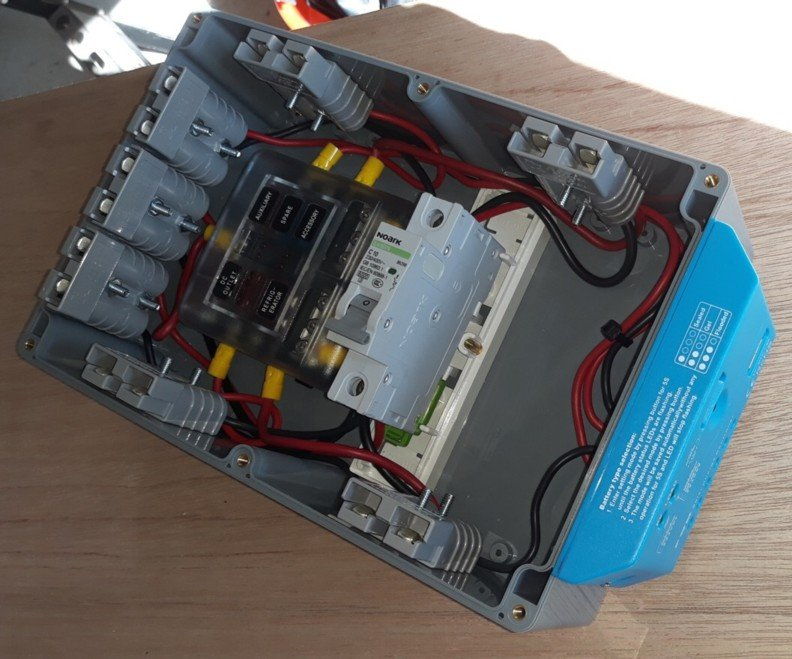
New MPPT Controller
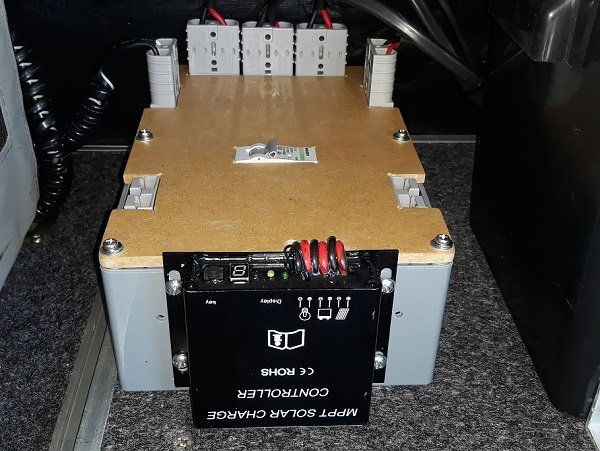
I then did some load testing
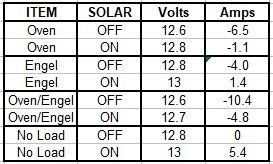
Two points to note;
1. After less than an hour the battery SOC was 93% (100 AH)
2. The last row in the table shows the battery voltage and amps input from the solar panel, within 2 -3 minutes the voltage gradually increased to 13.8 volts and the input current went down to 3.4 amps as the controller assessed the battery condition and adjusted accordingly.
BTW, My mate is selling these at $85 ea.
Conclusion - It is very difficult to compare solar controllers unless done at exactly the same time, with 2 systems using identical batteries and panels etc. But based on my previous checks of the original PWM controller and a bit of a gut feeling, lol, I reckon between 10-15% at least better output. The thing I can't measure - I'm pretty confident the other benefit will be battery longevity as the MPPT is kinder to the battery. Most good MPPT controllers will give more output and be better for a battery.
As Was

New MPPT Controller

I then did some load testing

Two points to note;
1. After less than an hour the battery SOC was 93% (100 AH)
2. The last row in the table shows the battery voltage and amps input from the solar panel, within 2 -3 minutes the voltage gradually increased to 13.8 volts and the input current went down to 3.4 amps as the controller assessed the battery condition and adjusted accordingly.
BTW, My mate is selling these at $85 ea.
Conclusion - It is very difficult to compare solar controllers unless done at exactly the same time, with 2 systems using identical batteries and panels etc. But based on my previous checks of the original PWM controller and a bit of a gut feeling, lol, I reckon between 10-15% at least better output. The thing I can't measure - I'm pretty confident the other benefit will be battery longevity as the MPPT is kinder to the battery. Most good MPPT controllers will give more output and be better for a battery.
condor22
Mike
PS You can just see at the left of the controller wires a small black wire, this is the temp sensor I mentioned in a previous post.
I also saw the panel output as high as 6.5 amps and the panel is flat on the roof of the 4x4. It's rated max is 6.24, go figure, lol.
It's rated max is 6.24, go figure, lol.
I also saw the panel output as high as 6.5 amps and the panel is flat on the roof of the 4x4.
- Joined
- Aug 27, 2020
- Messages
- 169
- Reaction score
- 137
That new "MPPT" Controller looks suspiciously just like this one on eBay:
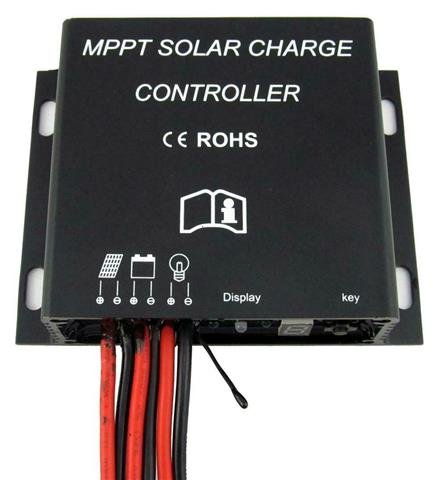
https://www.ebay.com.au/itm/AU-MPPT...809468?hash=item594dc472fc:g:xKgAAOSwiwZcLcNg
I run them in 20A and 30A.
They are MPPT by name only, but not by operation........they are PWM.....although quite a good one from my experience.
If you scroll down the eBay listing you will see a disclaimer:
Notice: This is not ture (sic) MPPT controller,if you want to buy ture MPPT,please don't buy it.
And they don't cost $85.....not on eBay at least.

https://www.ebay.com.au/itm/AU-MPPT...809468?hash=item594dc472fc:g:xKgAAOSwiwZcLcNg
I run them in 20A and 30A.
They are MPPT by name only, but not by operation........they are PWM.....although quite a good one from my experience.
If you scroll down the eBay listing you will see a disclaimer:
Notice: This is not ture (sic) MPPT controller,if you want to buy ture MPPT,please don't buy it.
And they don't cost $85.....not on eBay at least.
condor22
Mike
I'm gonna have to get back to you on that one, after I have the mandatory chat with my mate, thanks for the heads up.
condor22
Mike
Got back from my mate, showed him the print out of the Ebay charger. Although he is not familiar with it specifically, he has no doubt that it probably comes from the same supplier.
Where it differs is inside. He changed the primary integrated circuit (IC) that controls the charging algorithm to his specs as true MPPT, a. to improve the charging rate and b. to better protect the battery, then sent the specs and ordered a small quantity. It is a semi dumb MPPT compared to a Victron and for $85 I know I'm not getting a Victron Blue lol. Comparing the online price of around $30 to his $85, is very subjective. The one on Ebay, is probably manufactured in the 10s of thousands, whereas, he only had a small batch of 50 manufactured.
That the controller I got from him is actually producing more than the panels Maximum Power Current (Imp) in good sunlight means it's doing its job.
My logic for going a little cheaper on the 4x4 compared to the caravan is that when I'm away I live in the van, using a constant and as high as I want to go depth of cycle.
Although the Engel is on in the 4x4, I don't live in it. Notwithstanding the differences in charging technique.
I may have mentioned this before, but the Victron he provided me for the caravan was adjusted internally by him and again to his specs to lower the float voltage below "gas off" voltage level. Again, the difference between it and a cheapy, in that it is programable without changing internal hardware.
Where it differs is inside. He changed the primary integrated circuit (IC) that controls the charging algorithm to his specs as true MPPT, a. to improve the charging rate and b. to better protect the battery, then sent the specs and ordered a small quantity. It is a semi dumb MPPT compared to a Victron and for $85 I know I'm not getting a Victron Blue lol. Comparing the online price of around $30 to his $85, is very subjective. The one on Ebay, is probably manufactured in the 10s of thousands, whereas, he only had a small batch of 50 manufactured.
That the controller I got from him is actually producing more than the panels Maximum Power Current (Imp) in good sunlight means it's doing its job.
My logic for going a little cheaper on the 4x4 compared to the caravan is that when I'm away I live in the van, using a constant and as high as I want to go depth of cycle.
Although the Engel is on in the 4x4, I don't live in it. Notwithstanding the differences in charging technique.
I may have mentioned this before, but the Victron he provided me for the caravan was adjusted internally by him and again to his specs to lower the float voltage below "gas off" voltage level. Again, the difference between it and a cheapy, in that it is programable without changing internal hardware.
- Joined
- Sep 4, 2014
- Messages
- 8,935
- Reaction score
- 6,776
That's good your engineer recalibrated the out put to 13.1v because that is what they should be charged at @32*c and the colder the Ambient temp the Higher the float charge should be, 13.85v is the maximum for temps between 16*-21*c with an optimal voltage of 13.55v,condor22 said:I'm loath to discuss Lithium, as I'm still learning, lol. However, if anyone is interested, I'll note some of what I've found out. As I may have mentioned, there is a friend of mine that runs a business called Nimbus Engineering, which specialises in motorhome and caravan off grid power. He supplied my caravan panels and Victron controller. As an aside, he reprograms the float voltage of the Victron in float mode form 13.8 V down to 13.1. The reason, an AGM continues to "gas" off at anything over 13.2 V so why stress it.
On to Lithium, as an electronics engineer/designer, he receives a lot of technical data from all over the world. The one he mentioned in particular was that an Australian company received funding (over $9 mil) to test dozens of Lithium deep cycle batteries from all over the world. The tests were broken into 8 phases and conducted over 18 months and resulted in a 300+ page report, he has a copy of. I've only briefly discussed this with him and comments made (by him) include; "At the end of phase one, 15 batteries failed" (tests got progressively heavier duty, including loads, charging and environmental). "At the end of each test phase, more and more batteries failed".
The final comment; "At the end of phase 8, only 2 batteries had survived and passed all phases, a Tesla and a Pulmantech."
Which leads me to mention the latter. He's not a huge fan of Lithium, but is now a supplier of the Pullmantech. I've seen one and although he's sold a few, still to do some testing of his own. It has an all metal case, roughly 11kg, has an internal BMS, an on/off switch on top of the battery (push button), a gauge showing battery capacity and is a 100 AH. I believe it is a bit under $1,000.
More.....
Here is a chart that backs up what you are saying,
Hope that helps,
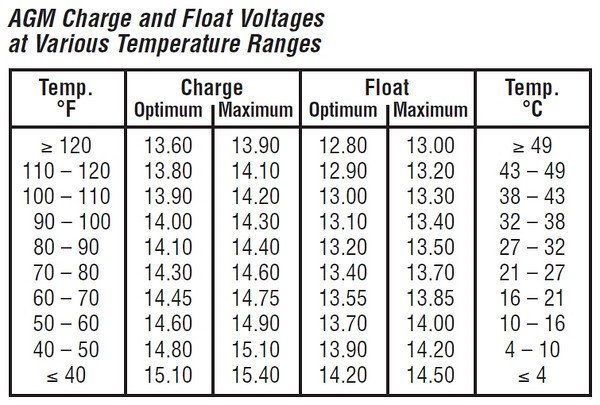
condor22
Mike
Thanks for the info RR. I've been gleaning knowledge from him for near 8 years now, coupled with my own. He knows his stuff. As a consequence, I've found that my setup does exactly what I set it up to do and get the best from a battery. Excepting when I inadvertently leave things on and flatten a battery, lol.
Like I've said before, no matter how foolproof you make something, some idiot will come along and stuff things. On that occasion me the idiot.
Merry Xmas
Like I've said before, no matter how foolproof you make something, some idiot will come along and stuff things. On that occasion me the idiot.
Merry Xmas
- Joined
- Sep 4, 2014
- Messages
- 8,935
- Reaction score
- 6,776
My 80Ah AGM seems to be working well seeing as it was stuffed and I had to buy a new one for the Camper, I have been running the little Dometic 18L from it for the last 45 hours and it is still holding good voltage, Running on the AGM the 18L is using close to 7Ah per 24 hours,
My 2 110/115 DC FLA's seem to hold much higher voltage after coming off the Charger, It's been 24 hours since I took them off of the Charger and they are still reading 13.265v which will run the ARB for 2 or 3 days before it gets down to 12.8/12.9v, the down side is the recharge time, I ran the Dometic 18L from them for 8 Days and they were still reading above 12.5+ volts before I put them on charge, Running the 18L from the FLA's the 18L was chewing about 7.2Ah per 24 hours which is still impressive, The difference in the power draw between the two battery types I put down to how the fridge is packed with me using it every day
The Low power draw is really important when it comes to using Solar to recharge the batteries because In the winter time here it does not get light until after 07:30 in the morning and it is Dark by 16:30 in the Afternoon which leaves less than 9 hours of daylight with means I get about 7 hours max of normal light to run a panel,
My 2 110/115 DC FLA's seem to hold much higher voltage after coming off the Charger, It's been 24 hours since I took them off of the Charger and they are still reading 13.265v which will run the ARB for 2 or 3 days before it gets down to 12.8/12.9v, the down side is the recharge time, I ran the Dometic 18L from them for 8 Days and they were still reading above 12.5+ volts before I put them on charge, Running the 18L from the FLA's the 18L was chewing about 7.2Ah per 24 hours which is still impressive, The difference in the power draw between the two battery types I put down to how the fridge is packed with me using it every day
The Low power draw is really important when it comes to using Solar to recharge the batteries because In the winter time here it does not get light until after 07:30 in the morning and it is Dark by 16:30 in the Afternoon which leaves less than 9 hours of daylight with means I get about 7 hours max of normal light to run a panel,
condor22
Mike
Ridge Runner said:The Low power draw is really important when it comes to using Solar to recharge the batteries because In the winter time here it does not get light until after 07:30 in the morning and it is Dark by 16:30 in the Afternoon which leaves less than 9 hours of daylight with means I get about 7 hours max of normal light to run a panel,
Which in solar terms is barely 2 sun hours per day.
- Joined
- Sep 4, 2014
- Messages
- 8,935
- Reaction score
- 6,776
condor22 said:Ridge Runner said:The Low power draw is really important when it comes to using Solar to recharge the batteries because In the winter time here it does not get light until after 07:30 in the morning and it is Dark by 16:30 in the Afternoon which leaves less than 9 hours of daylight with means I get about 7 hours max of normal light to run a panel,
Which in solar terms is barely 2 sun hours per day.
I was kind of hoping It would be closer to around 4 hours per day, 8.( 8.(
Which Is why those PLB's are better suited for uk weather when it comes to driving and camping if you don't have the roof space to mount more than 2 150w panels, To achieve the same power you get from One 150w panel in a day I would need a minimum of 6 panels in Autumn and Winter, Where as a PLB will charge in a couple of hours and in the cooler weather it will run the 18L fridge for about 4 and a half days and about 3 days in the warm months and it will run the ARB for about 2 and a half days in the warmer months,
The bigger 78L set to -16*c will use most of the PLB's power in 24 hours but it can be fully charged in 3 to 4 hours Max,
I was looking at getting a Victron DC - DC but I am not sure which size to get, Do you know if they are any good and do you connect them to the Alternator or the Vehicle's Battery, ??
condor22
Mike
I have no experience with Victron DC-DC, however, I do use their Blue solar controller. It's a good brand, the one I use is a 20 amp Redarc and it does the job. 
Re connection - I work on this logic - The only thing connected to the vehicle alternator is what the vehicle manufacturer has connected to it. The vehicle battery is the "Ballast" (for want of a better word) for the entire system, so if you add anything i.e. spotties, DC-DC or anything else take it off the start battery. It also cushions the blow, so as to speak.
The first proviso, is whatever you connect, make sure it does not deplete the start battery when the engine is off. In the case of my Redarc, there is a blue wire that is meant to go to IGN. If wired this way it senses the engine is off and if the start battery voltage falls below a certain point the DC-DC stops charging, but it still takes something out before this.
However, I prefer old school, absolute certainty. As I also tow a caravan with a 3 way fridge pulling 13 amps, I wanted to make sure the fridge disconnects so I installed an IGN controlled 70 amp continuous solenoid (the old round can type). It makes when engine on and sends power to the Anderson connector on the rear bumper that the van plugs into. To power the DC-DC I ran a 2nd twin pair to the inside of the rear that feeds the Redarc. When doing this the Redarc Red/Black wires are the +/- to the car battery via the solenoid. I jumped the Redarc Blue to the Redarc Red wire as a quasi IGN feed. So when engine off, no power to the Red or Blue, but when engine on both get a + feed.
I have a 30 amp fuse near the solenoid on each of the + wires to the rear, the - wire goes to the start battery, not the chassis. There is also a 40 amp fuse between the solenoid and the battery.
I also added a relay in the rear powered by tapping the Red feed from the solenoid. The NC run is solar panel + in then to the controller. So when the relay fires up the panel disconnects as the Redarc is charging, then with engine off the contacts close and solar is charging. The Redarc is off anyway as the IGN is off and the solenoid breaks.
Hope that's not too confusing, lol.
Re connection - I work on this logic - The only thing connected to the vehicle alternator is what the vehicle manufacturer has connected to it. The vehicle battery is the "Ballast" (for want of a better word) for the entire system, so if you add anything i.e. spotties, DC-DC or anything else take it off the start battery. It also cushions the blow, so as to speak.
The first proviso, is whatever you connect, make sure it does not deplete the start battery when the engine is off. In the case of my Redarc, there is a blue wire that is meant to go to IGN. If wired this way it senses the engine is off and if the start battery voltage falls below a certain point the DC-DC stops charging, but it still takes something out before this.
However, I prefer old school, absolute certainty. As I also tow a caravan with a 3 way fridge pulling 13 amps, I wanted to make sure the fridge disconnects so I installed an IGN controlled 70 amp continuous solenoid (the old round can type). It makes when engine on and sends power to the Anderson connector on the rear bumper that the van plugs into. To power the DC-DC I ran a 2nd twin pair to the inside of the rear that feeds the Redarc. When doing this the Redarc Red/Black wires are the +/- to the car battery via the solenoid. I jumped the Redarc Blue to the Redarc Red wire as a quasi IGN feed. So when engine off, no power to the Red or Blue, but when engine on both get a + feed.
I have a 30 amp fuse near the solenoid on each of the + wires to the rear, the - wire goes to the start battery, not the chassis. There is also a 40 amp fuse between the solenoid and the battery.
I also added a relay in the rear powered by tapping the Red feed from the solenoid. The NC run is solar panel + in then to the controller. So when the relay fires up the panel disconnects as the Redarc is charging, then with engine off the contacts close and solar is charging. The Redarc is off anyway as the IGN is off and the solenoid breaks.
Hope that's not too confusing, lol.
condor22
Mike
I should add, I bought my Redarc before they produced the solar version that takes feeds from both. It is not a solar controller version, so my relay add was to make it automatic switching with a separate solar controller . The distribution box has a 10 amp circuit breaker so I can isolate the panel at anytime.
condor22 said:I
Re connection - I work on this logic - The only thing connected to the vehicle alternator is what the vehicle manufacturer has connected to it. The vehicle battery is the "Ballast" (for want of a better word) for the entire system, so if you add anything i.e. spotties, DC-DC or anything else take it off the start battery. It also cushions the blow, so as to speak.
You know your stuff Condo, however the only electrics connected to my "start battery" are the original vehicle components.
The start battery and the auxiliary are separated by a solenoid, like you mention, controlled by ignition key. All the extras you mention, plus extras, are powered by the auxiliary and charging is activated when the ignition is in "start" position and engine is running.
condor22
Mike
NJ - I missed a point, lol.
I would do exactly as you have, if my Aux Battery was under the hood. Unfortunately there aint room under my hood, so the Aux is in the rear, which is problematic to then run power forward to the spotties etc.
I don't have a bull bar only a nudge, so all there is up front are the spots and they, by law, are hooked to the high beam anyway and almost impossible to leave on without the engine going. I say almost cos I could, but they would be obviously on. My CB is hooked to the internal fuse area and isolated when IGN off. But I always carry a 5 W handheld 80 ch anyway. I have an adaptor I can plug it into the antenna if needs be. Covering all bases....
So all my Aux Bat needs are in the rear, fridges, oven and solar etc. So is the battery and all the charging devices. Sometimes a pain as it takes space, but I'm usually alone when detecting so have the front passenger seat and the whole rear seat + floors to play with.
Either way is not a problem, if done properly, horses for courses, lol.
I would do exactly as you have, if my Aux Battery was under the hood. Unfortunately there aint room under my hood, so the Aux is in the rear, which is problematic to then run power forward to the spotties etc.
I don't have a bull bar only a nudge, so all there is up front are the spots and they, by law, are hooked to the high beam anyway and almost impossible to leave on without the engine going. I say almost cos I could, but they would be obviously on. My CB is hooked to the internal fuse area and isolated when IGN off. But I always carry a 5 W handheld 80 ch anyway. I have an adaptor I can plug it into the antenna if needs be. Covering all bases....
So all my Aux Bat needs are in the rear, fridges, oven and solar etc. So is the battery and all the charging devices. Sometimes a pain as it takes space, but I'm usually alone when detecting so have the front passenger seat and the whole rear seat + floors to play with.
Either way is not a problem, if done properly, horses for courses, lol.
- Joined
- May 18, 2015
- Messages
- 707
- Reaction score
- 1,222
Hi All, Just fitted my new Lithium Battery into a Projecta Power box to run a little Dometic 32L fridge in the back of my trailer, worked fine topping up with a 120W solar blanket, no problems so far. Now Just need to work out how to set the solar regulator to suit a Lithium Battery as the settings on the Projecta blanket are for traditional batteries only.
Got free delivery to Vic $780 Black Friday sale.
Cheers
https://itechworld.com.au/collectio...itech120x-water-proof-ip67-380a-max-discharge
Got free delivery to Vic $780 Black Friday sale.
Cheers
https://itechworld.com.au/collectio...itech120x-water-proof-ip67-380a-max-discharge
Similar threads
- Replies
- 12
- Views
- 2K
- Replies
- 2
- Views
- 1K


